| image | name | launched | notes |
|---|
| Adanac | |
- Schooner operating out of Aklavik in the Mackenzie Delta c. 1940.
|
| Aggie May | |
- Fish packer owned by Menzies Fisheries on Great Slave Lake c. 1962.
|
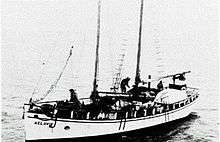 | Aklavik | 1923 |
- Motor schooner (58' long, 16' beam, 5' draft, Fairbanks-Morse diesel engine) built in Fort Smith 1923 by George Askew, and used by the Hudson's Bay Company in the Western Arctic Ocean and Mackenzie Delta from 1923 to 1928, followed after salvage and repairs with service in the Northwest Passage to Cambridge Bay and King William Island. In 1942 it was sold to Patsy Klengenberg of Cambridge Bay. It was destroyed by fire on August 31, 1946 in port at Cambridge Bay, killing Mr. Klengenberg. [4]
|
| Aklavik I | |
- Motor schooner used by Royal Canadian Mounted Police for patrols in the Mackenzie Delta, Aklavik area c. 1936.
|
| Aklavik II | 1953 |
- Motor schooner (45' long, 83 hp diesel engine) used by Royal Canadian Mounted Police for patrols in the Mackenzie Delta, Aklavik and Inuvik area 1954–1960. Renamed the RCMP Jennings in 1961.
|
| Alcan | |
- Steamboat sternwheeler operated during the 1940s on the Peace River near Fort St. John. In 1946, it was purchased by Imperial Oil Limited and moved over the Vermillion Chutes for use on the Slave/Athabasca Rivers and possibly further north in the Mackenzie River routes. [5]
|
| Alcan II | |
- Motor tugboat used by Pfeffer Trading Company on the Mackenzie River with home port of Inuvik, Northwest Territories, in c. 1961/1962.
|
| Alpha (aka Alfa) | 1903 |
- Steamship built in 1902/1903 by Nagle & Hislop Traders at Fort Resolution, Great Slave Lake. It was moved over the portage in 1903 to serve the Slave/Athabasca River routes between Fort Fitzgerald and Fort McMurray.
|
| Angus Sherwood | 1969 |
- Diesel tugboat (160' long, 40' beam, 5'6" draft, 4300 hp) launched by Northern Transportation Company Limited in 1969 for use in the Western Arctic of the NWT. Renamed the Kitikmeot, and then Pat Lyall.
|
| Arctic Dutchess | 1961 |
|
| Arctic Kugaluk | 1973 |
- Diesel tugboat (31 m long, 11.6 m beam, 1.4 m draft) launched by Northern Transportation Company Limited in 1973 for use on the Mackenzie River. New engines installed 2003. Home port is Hay River.
|
| Arctic Lady | |
- Boat owned by Yellowknife Transportation Company on Great Slave Lake in 1963.
|
| Arctic Rover | 1918 |
- Tug boat owned by Arctic Shipping Limited in the Western Arctic Ocean to Tuktoyaktuk, 1958-1962. It was formerly a Royal Canadian Navy minesweeper vessel, the HMCS Armentières from 1918 to 1947. [6]
|
| Argo | |
- Steamship used on Great Slave Lake in 1899 during early gold prospecting in the area. Owned by Fred Gaudet in 1899.
|
 | Atha (MV) | 1957 |
- Diesel tugboat operating on the Athabasca River in the 2000s owned by Guy Thacker of Fort Chipewyan, Alberta. In 2002, a boat with this name was drydocked at the Con Mine site in Yellowknife.
|
 | Athabasca (SS) | 1888 |
- Steam-driven sternwheeler (135' long, 28' beam) operated by the Hudson's Bay Company, built in 1888 to operate from Athabasca Landing to Grand Rapids on the Athabasca River and Lesser Slave Lake. It was decommissioned in 1899.
|
| Athabasca River (SS) | 1912 |
- Steam-driven sternwheeler (136' long, 28' beam, 340 tons gross tonnage) built and launched in 1912 at Athabasca Landing by the Hudson's Bay Company to operate on the Athabasca and Upper Peace River. The vessel was decommissioned in 1920 and hauled up on the banks of Peace River, Alberta and used as a warehouse by the HBC until destroyed by fire in 1930.
|
 | Athabasca River | 1922 |
- Steam-driven sternwheeler (146' long, 36' beam, 200 tons cargo, 48 passengers) built and launched in 1922 by the Hudson's Bay Company to operate between Fort McMurray and Fort Fitzgerald on the Athabasca and Slave Rivers. The vessel was overhauled in 1936, and operated until about 1946.
|
| Aurora Surveyor | 1970 |
- A research vessel (24.7 m long, 7.3 m beam, steel-hulled, twin screw 240 bhp engines) built by Alem Construction Company in 1970 in Hay River. It was later used as a freighter by Arctic Transportation Ltd. In 1990, it was sold to Steve McGovern and Wendy Irvine and towed to Yellowknife for conversion into a houseboat, where it remains today (2017).[7]
|
| Aurous | |
- Boat owned by R.M. Wynn, sawmill operator on the Jean/Slave River c. 1942, who used it for hauling lumber to Yellowknife and other communities around Great Slave Lake.
|
| B.E.A.R. | 1932 |
- Diesel boat cabin cruiser (35' long) commissioned by Bear Exploration and Radium Limited for use on Great Bear Lake, Northwest Territories and used to support its silver and uranium mine 1932–1939. Built by Captain J. Matheson in Edmonton. Later abandoned near Port Radium.
|
| Banksland (MV) | 1953 |
- Diesel tug boat (166' long, 27' beam, 10' draft, 500 hp, 650-ton cargo capacity). It was originally the MS Auriga, purchased by the HBC in 1956 and used in the Western Arctic Ocean to supply its trading posts for many years. From 1965 to 1980 it was owned by the Northern Transportation Company.
|
| Barbara Jean | |
- Boat owned by Fred Norris at Aklavik, Mackenzie Delta c.1956.
|
| Beaufort Sea Explorer | 1971 |
- Tug boat (2500 hp) owned by Kaps Transport Limited for use on the Mackenzie River and Beaufort Sea, launched in June 1971. [8]
|
| Beaver Lake (MS) | |
- Diesel tug owned by the Hudson's Bay Company on the Athabasca/Slave River routes c. 1939 – c. 1946.
|
| Birch (MB) | 1954 |
- Motor boat owned by Government of Canada on Great Slave Lake with home port in Yellowknife. It was used by the Game Warden and other federal officials during summer patrols, 1954 – c. 1957.
|
| Blue | |
- Diesel tug (100 hp) owned by Jim McRitchie, operator of a sawmill on the Slave River in 1947. The boat moved milled lumber to customers in Yellowknife and around Great Slave Lake.
|
| Buffalo (MB) | |
- Motor boat used by Government of Canada on Great Slave Lake c. 1949 – 1961 with home port in Fort Smith, Slave River. It was used by the Game Warden and other federal officials in management and patrols of the Slave River and Great Slave Lake areas until its retirement in 1961. Captained by Billy McNeill from 1951–1961. Replaced by the MV Inconnu in 1962.
|
| Buffalo Lake (MS) | |
- Motor boat owned by Hudson's Bay Company in 1939
|
| C.E. Sloan | 1932 |
- Diesel boat cabin cruiser (35' long) commissioned by Great Bear Minerals Limited for use on Great Bear Lake, Northwest Territories and used to support its silver prospecting 1932–1933. Built by Captain J. Matheson in Edmonton.
|
| Canadusa | |
- Gas boat operated by Alberta Arctic Transportation Company in 1921, followed by the Hudson's Bay Company (1924 – c. 1932) on the Athabasca River and lower Peace River, and on Lake Athabasca to Fond du Lac.
|
| Cameron Bay | |
- Motor boat used by the Royal Canadian Mounted Police at its post at Cameron Bay/Port Radium on Great Bear Lake in 1935.
|
| Cariboo | 1902 |
- Steamboat built by Bill Connor at Fort Smith and launched in 1902. It was purchased by free-traders Hislop & Nagle in 1903 and used to supply its trading posts along the Slave/Mackenzie Rivers and Great Slave Lake. Northern Traders Company purchased all Hislop & Nagle assets in 1911. The Cariboo' was eventually replaced by Northern Trader's smaller more efficient schooner Speed. The old boat was derelict at Nagle Snye (former shipyard for Hislop & Nagle) outside of Fort Resolution in 1927.
|
| Caribou (MB) | |
- Originally the Medico. By 1956/1957 it was called the Caribou was being used by the Game Warden in Aklavik, Mackenzie Delta.
|
| Cecilia (MV) | |
- Fish packer owned by Alaska Fisheries on Great Slave Lake c. 1962/1963.
|
| Clearwater | |
- Diesel tug (270 bhp) owned by Northern Transportation Company Limited on the Athabasca and Slave Rivers in northern Alberta, 1946–1956. On August 26, 1956, the vessel sank on Lake Athabasca killing eight crew members. The Clearwater was later salvaged and renamed the Horn River. It may have originally been a US Army tug boat used on the Mackenzie River during construction of the Canol pipeline c. 1944, carrying the designation RT-903.
|
| Coregonus | |
- Motor boat used by Department of Fisheries patrols on Great Slave Lake 1945–1955, with home port of Hay River, Northwest Territories.
|
| Cross Fox | |
- Diesel tug owned by the HBC on the Athabasca and Slave Rivers in northern Alberta, c. 1939 – c. 1946.
|
| D.A. Thomas | 1916 |
- Steam-driven sternwheeler (187' long, 37' beam, 300-ton cargo, 300 passenger) built for Peace River Development in 1916 to operate on the Peace River above the Vermillion Chutes. Sold to Lamson-Hubbard in 1920, then to Alberta Arctic Transportation in 1921 and finally to the HBC in 1924. The shipped was badly damaged while trying to run the Vermillion Chutes on the Peace River and scrapped in 1930. It was one of the larger paddle wheeler steamships to ply in the Mackenzie watershed.
|
| Dease Lake (MV) | 1934 |
- Diesel tug (72 hp Fairbanks Morse engine) launched at Fort Smith in 1934 and owned by the HBC for use on the Slave/Mackenzie Rivers/Great Slave Lake.
|
| Diana H | |
- Fishing boat owned by Carter Fisheries c. 1961 – c. 1963 on Great Slave Lake, home port of Hay River.
|
 | Distributor (SS) | 1920 |
- Steam-driven sternwheeler (176' long, 30' beam, 200 ton cargo, 250 passengers) placed in service in 1920 by the Lamson & Hubbard Co., acquired by the Alberta Arctic Transportation Co. in 1921, and the Hudson's Bay Company in 1924. Operated on the Slave-Mackenzie River network, below Fort Smith on the Slave River, in the 1920s–1940s. Converted to oil in 1944. Decommissioned in 1946. Scrapped in the 1950s.[9]
|
| Dumit (CCGS) | 1958 |
- Coast Guard vessel operated by the Department of Transport on Great Slave Lake beginning in 1958. It was replaced with a new vessel called Dumit late in 1979.[10]
|
| Eckaloo (CCGS) | 1961 |
- Coast Guard vessel built by Allied Ship Builders in 1961 at Fort Smith on the Slave River. The Department of Transport used it for coast guard activities and Aids to Navigation from Great Slave Lake and up the Mackenzie River. Rebuilt in 1967. It was replaced by a new Eckaloo vessel in 1988, and renamed the Hay River II, and then the Arctic Dutchess in 1995 at which time it was owned by the Department of Fisheries. It was sold to RTL in 2001 and again in 2014 to a private owner in Yellowknife, where it is currently (2017) being used as a living quarters on Yellowknife Bay.
|
| Edjack | |
- Robert Porritt's boat on Great Slave Lake, used for hauling lumber to Yellowknife and other communities around Great Slave Lake/Mackenzie River from his sawmill on the Slave River c. 1940s
|
| Egaluppik (MV) | |
- A diesel tug (40' long, 13' beam, 4' draft) owned by the Government of the NWT in Inuvik in 1970.
|
| Eldora | |
- Pleasure craft used by employees of the Port Radium uranium mine on Great Slave Lake c. 1939 – c. 1947.
|
| Ell-Too (MV) | |
- Diesel tug owned by Yellowknife Transportation Company on the Mackenzie River c. 1946.
|
| Enterprise | |
- Steamboat (50' long) owned by Bill Connor, free trader, on Athabasca River c. 1898. He successfully floated the boat over the rapids on the Slave River (after removing the boiler and portaging it over the rapids) and was using it on Great Slave Lake that summer.
|
| Ethel | |
- Steamlaunch used by prospectors on Great Slave Lake in 1899 and then sold to J.S. Camsell. Dr. Robert Bell of the Geological Survey of Canada was using the boat during his mineral examinations around the lake in 1899.
|
| Eva Nagle | 1900 |
- (originally the Sparrow). Purchased in 1898 by Hislop & Nagle free traders, and renamed the Eva Nagle. They moved it down the Slave River for use on Great Slave Lake and the Mackenzie River, relaunching it in 1900 when it travelled as far north as Fort Good Hope. Northern Traders Company purchased all Hislop & Nagle assets in 1911.
|
| Evelyn | |
- Gas schooner owned by fur trader Jim Darwish on Great Slave Lake c. 1932, home port Fort Rae (Behchoko). It was wrecked at Gypsum Point on Great Slave Lake in September 1932.
|
| Fond du Lac | |
- Gas schooner owned by the Hudson's Bay Company on Lake Athabasca c. 1923/1924.
|
| Fort Hearne (MS) | 1948 |
- Freighting vessel owned by the Hudson's Bay Company and used to supply its post in the Western Arctic Ocean of the Northwest Territories from 1948 to 1961 when it was damaged by ice.
|
| Fort James (MS) | |
- Freighting vessel owned by the Hudson's Bay Company and used to supply its post in the Western Arctic Ocean of the Northwest Territories from c. 1928 to 1937 when it was crushed by ice.
|
| Fort McMurray | 1916 |
- Steam-driven sternwheeler (100 ton cargo, 40 passengers) built at Fort McMurray and launched in 1916 to operate between Fort McMurray and Fort Fitzgerald on the Athabasca River by the Hudson's Bay Company. Out of service by 1921.
|
| Fort Rae | |
- RCMP schooner used on Great Slave Lake c.1921-1922. Possibly also used by Hudson's Bay Company c. 1923. In 1921, the 'Fort Rae' was being used by the government agent in charge of signing Treaty 11 with various Dene bands on Great Slave Lake.
|
| Fort Reliance | |
- RCMP schooner used on Great Slave Lake c. 1928
|
| Fort Ross (MS) | 1938 |
- Freighting vessel (114' long, 28' beam) owned by the Hudson's Bay Company and used to supply its post in the Western Arctic Ocean of the Northwest Territories from 1938 to 1950. In 1958, it was on an exploratory fishing voyage in the North Pacific Ocean for the Fisheries Research Board.
|
| Frank Broderick | 1965 |
- Diesel tugboat (280' long, 42' beam, 10" draft, 2880 hp) launched by the Northern Transportation Company for use in the Western Arctic Ocean of the NWT. It was based in Tuktoyaktuk. NTCL sold it in 1995.
|
| George Askew | |
- Steam-powered sternwheeler (135 hp) owned by Northern Transportation Company on the Mackenzie River routes c.1944-c.1947.
|
| Golden Hind | |
- Schooner owned by Harry Harrison at Aklavik, Mackenzie Delta c. 1940 – c. 1956.
|
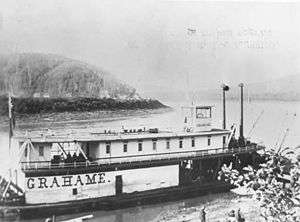 | SS Grahame | 1883 |
- Steam-driven sternwheeler (130' long, 24' beam, 450 ton cargo) operated by the Hudson's Bay Company, launched in 1883 by Captain J.M. Smith, operating from Ft. McMurray to Fort Fitzgerald on the Athabasca and Slave Rivers.[11]
|
| Grandy | |
- Diesel tug owned by Yellowknife Transportation Company on Great Slave Lake c. 1962/1963.
|
| Great Bear (MV) | 1934 |
- Diesel freighter (90' long, 240 bhp, 135 ton capacity) used by Northern Transportation Company on Great Bear Lake from 1934 to 1960 when it was retired.
|
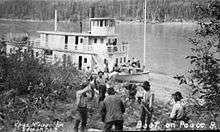 | Grenfell | 1912 |
- Built for service on the upper Peace River, by the Peace River Trading and Land Company. It was accidentally destroyed by fire in September 1914.[12]
|
| Guy | |
- Diesel boat used by sawmill operator A.J. MacDonald (c. 1944), followed by the Sheck Brothers (c. 1945), and finally Charles Sanders (c. 1950s) on Great Slave Lake. Derelict on Jolliffe Island at Yellowknife and destroyed by fire 1970s.
|
| Guy (MV) | |
- Roman Catholic mission boat on the Mackenzie River c. 1961.
|
| Hearne Channell | |
- Diesel tug boat operated by David Smith on Great Slave Lake with home port in Yellowknife, c. 1980s – 2000s. Frequently used for freighting on the lake's East Arm to mining projects and the communities like Lutselk'e.
|
| Hearne Lake (MV) | 1934 |
- Diesel tug (72 hp Fairbanks Morse engine) launched at Fort Smith in 1934 and owned by the HBC for use on Great Bear Lake. It was later used on the Slave/Mackenzie Rivers/Great Slave Lake routes, and was still in service in 1956
|
| Henry Christoffersen | 1973 |
- Diesel tugboat (148.5' long, 52' beam, 3'9" draft, 4500 hp) launched by Northern Transportation Company Limited in 1973 for use in the Western Arctic of the NWT. Still in use 2013.
|
| Herchell Island | |
- Schooner used by the Royal Canadian Mounted Police at Herchell Island starting in 1956.
|
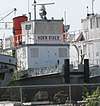 | Horn River | |
- This vessel (80' long, 20' beam, 2'8" draft, 460hp) was apparently the retrofitted Clearwater diesel tug that sank on Lake Athabasca in 1956 and then salvaged. It was rebuilt for service on the Mackenzie River by Northern Transportation Company. Now drydocked at the NTCL shipyards in Hay River.
|
| Hudson's Hope | 1920 |
- A steam-driven sternwheeler relaunched in 1920 on the Peace River, originally the Northland Call. Operated by Peace River Development from 1920 to 1924 when it was scrapped.
|
| Hubaco | |
- Boat owned by the Hudson's Bay Company c. 1921–1939 on the Mackenzie River/Great Slave Lake routes. In 1921, the 'Hubaco' was being rented from the HBC by the government agent in charge of signing Treaty 11 with various Dene bands up the Mackenzie River.
|
 | Hugh A. Young | 1962 |
- A survey vessel (87' long, 26' beam, 3'6" draft) built in 1961 by Allied Shipbuilders in Vancouver, and transported by rail to Waterways, Alberta in the summer of 1962. It then traveled down the Athabasca/Slave Rivers, over the portage at Fort Smith, and commissioned at Hay River for the use of Department of Public Works on Great Slave Lake/Mackenzie River. In the 1980s it was assisting with dredge work at Tuktoyaktuk. The vessel was drydocked and ready for sale in 1991. It was retrofitted and put back to use during remediation of several old mine sites on Great Slave Lake in 1994.[13]
|
| Husky | 1959 |
- Diesel tug (121' long, 30' beam, 5' draft, 2880 hp) launched by the Yellowknife Transportation Company in 1959 for use on the Great Slave Lake/Mackenzie River routes. It was the flagship of the YTCL. Sold to Northern Transportation Company Limited in 1965 and renamed NT Husky. Decommissioned in Hay River.
|
| Immaculata | |
- Roman Catholic mission boat based in Fort Resolution for use on Great Slave Lake/Mackenzie River/to the Arctic Ocean, 1940s – c. 1962. In 1962, it was hauling lumber from a sawmill near Fort Simpson to Fort Resolution. Later abandoned at Sawmill Channel near Fort Resolution.
|
| Inconnu (MV) | 1962 |
- Motor boat (39' long, 12' beam, 5'6" draft) used by Government of Canada on Great Slave Lake and Slave River starting in 1962 with home port in Fort Smith, Slave River. It was used by the Game Warden and other federal officials in management and patrols of the Slave River and Great Slave Lake areas. Captained by Billy McNeill in 1962. In 1965, the boat was reported sunk following a heavy rainstorm while operating near Inuvik. [14]
|
| Jock McNiven | 1974 |
- Diesel tugboat (148' long, 52' beam, 3'9" draft, 4500 hp) launched by Northern Transportation Company Limited in 1974 for use on the Mackenzie River. Later owned by the Government of the Northwest Territories Department of Public Works.
|
| Johnny B | 1956 |
|
| Johnny Berens | 1961 |
- Diesel-powered ferry built in Hay River in the winter of 1960/1961, and launched on July 20, 1961 as a ferry crossing the Mackenzie River. It was replaced by the ferry Merv Hardie in 1972. It is now used as a ferry crossing the Mackenzie River on the highway between Fort Simpson and Wrigley.
|
| Johnny Hope | 1973 |
- Diesel tugboat (148' long, 52' beam, 3'9" draft, 4500 hp) launched by Northern Transportation Company Limited in 1973 for use in the Western Arctic of the NWT. Renamed the Edgar Kotokak in 1995.
|
| Kakisa | 1973 |
- Diesel tugboat (83' long, 35' beam, 3" draft, 1450 hp) launched by Northern Transportation Company Limited in 1973 for use on the Mackenzie River with home port of Hay River. Later purchased by the Government of the Northwest Territories, Department of Public Works.
|
| Kay Tee | |
- A fishpacker owned by Kucher and Trefiak, commercial fishers, on Great Slave Lake c. 1961 – c. 1963. Aka Kaytee. Now derelict in Hay River.
|
| Keewatin | 1974 |
- Diesel tugboat (126' long, 38' beam, 6'6" draft, 3370 hp), built by Yarrows in Esquimalt, launched by Northern Transportation Company Limited in 1974 for use in the Western Arctic of the NWT.
|
| Kelly Hall | 1969 |
- Diesel tugboat (160' long, 40' beam, 5'6" draft, 4300 hp) launched by Northern Transportation Company Limited in 1969 for use in the Western Arctic of the NWT. Renamed the Pisurayak Kootook in 1995.
|
| Knut Lang | 1969 |
- Diesel tugboat (168' long, 48' beam, 5'6" draft, 4300 hp) launched by Northern Transportation Company Limited in 1969 for use in the Western Arctic of the NWT. Renamed the Nunakput in 1994.
|
| Lady Mackworth | 1919 |
- Gas motor vessel built by the Lamson & Hubbard Co. and acquired by the Alberta Arctic Transportation Co. in 1921 to operate on the Mackenzie and Liard River network. Acquired by the Hudson's Bay Company in 1924.
|
| Landa (MV) | |
- Commercial fishing vessel on Great Slave Lake c. 1961 - c. 1972, home port of Hay River. Owned by Alaska Fisheries Ltd. in the 1960s.
|
| Liard | 1919 |
- Paddlewheeler (80' long, 16' beam) launched in 1919 at Fort Smith to operate from Fort Simpson up the Liard River to service Hudson's Bay Company posts. It was wrecked on the Nelson River in October 1922.
|
 | Liard River (MT) | 1923 |
- Gas motor vessel launched in 1923 by the Hudson's Bay Co. to operate on the Slave/Mackenzie/Liard Rivers. It was moved to Great Bear Lake in 1932. The boat was still operating in 1946 by which time it was again operating on the Slave/Mackenzie River routes. In 1950 it was sold to McInnes Fish Products commercial fishers on Great Slave Lake. In 1962 the boat was purchased by Arctic Circle Shipping and retrofitted as a tourism cruise vessel for the Mackenzie River. In 1966, the boat was purchased by Terrex Explorations for use in mineral exploration along the Mackenzie River and Arctic Coast. In 1973, it was donated to the Hay River tourist centre for potential display.[15]
|
| Limnos | |
- Motor boat used by Department of Fisheries patrols on Great Slave Lake 1945–1955, with home port of Hay River, Northwest Territories.
|
 | Lister | 1970 |
- Diesel tugboat (72' long, 23' beam, 4' draft, 680 hp), built by Lister's Welding in Edmonton, owned by Northern Transportation Company Limited. Now drydocked at the NTCL shipyards in Hay River.
|
| Little Chief | 1937 |
- Diesel tugboat owned by Yellowknife Transportation Company on the Slave River/Great Slave Lake routes 1937 to c.1941. It was built in 1937 at Taylor Flats, British Columbia on the Peace River under a crew in charge of Bert Neiland, owner of Yellowknife Transportation Company. That first summer, the Little Chief and its barge made supply runs to Fort Nelson on the Liard River, Norman Wells, and was winched over the Bear River rapids to get to Port Radium on Great Bear Lake and transport out a shipment of uranium ore. [16]
|
| Mabel | |
- Boat used by Northern Waterways Limited (1932) and then Northern Transportation Company Limited (1934 – c. 1943) on the Athabasca/Slave River route.
|
 | Mackenzie River (SS) | 1908 |
- Steelframe steam-driven sternwheeler (125' long, 115 ton cargo, 40 passengers) built at Fort Smith and launched in 1908 by Captain J.W. Mills operating on Great Slave Lake in the 1920s by the Hudson's Bay Company. It was mothballed by the HBC in 1923 but re-entered service during 1929/1930. In the 1940s it was commissioned for use during the Canol oil project along the Mackenzie River but was no longer being operated in 1947. In 1953 the retrofitted hulk was being used as living quarters and warehousing for commercial fisherman at Gros Cap on Great Slave Lake. The following year it ran aground at Hay River and was renovated into a fish processing barge for the fisheries there. [17]
|
| Macleod | |
|
| Malta (MT) | |
- Tug boat used by Department of Public Works at Hay River to assist with dredge operations c. 1962/1963.
|
| Margaret A (MS) | |
- Schooner used by the Hudson's Bay Company c. 1934 – 1940 in the Western Arctic to Tuktoyaktuk, and later on the Mackenzie River and Great Slave Lake c.1941.
|
| Margaret A | |
- Diesel tug used by the Yellowknife Transportation Company on the Mackenzie River/Great Slave Lake routes c.1961.
|
| Mareca | |
- Motor boat used by Department of Fisheries patrols on Great Slave Lake until 1962, with home port of Hay River, Northwest Territories.
|
| Marila (MV) | |
- Motor boat used by Department of Fisheries patrols on Great Slave Lake c. 1962/1963, with home port of Hay River, Northwest Territories.
|
| Marjorie B | |
- Diesel tug used by the Yellowknife Transportation Company on the Mackenzie River/Great Slave Lake routes c. 1946
|
| Marjorie H | 1956 |
- Diesel tug (1000 hp), built in Victoria, used by the Yellowknife Transportation Company on the Mackenzie River/Great Slave Lake routes 1956–1965. Also known as the YT Marjory. Acquired by Northern Transportation Company in 1965 and renamed NT Marjory. The NT Marjory was rebuilt in 1973 and given new engines in 2001.
|
| Matt Berry | 1974 |
- Diesel tugboat (148' long, 52' beam, 3'9" draft, 4500 hp) launched by Northern Transportation Company Limited in 1974 for use in the Western Arctic of the NWT. Later owned by the Government of the Northwest Territories Department of Public Works. Renamed the Kelly Ovayuak in 2011.
|
| McKinnon | |
- Gas boat owned by the Hudson's Bay Company on the Slave/Mackenzie River routes c. 1946.
|
| McQuesten | 1971 |
- Ferry used at the Liard River crossing to Fort Simpson in the 1970s. Now retired and privately owned in Yellowknife.
|
| Medico | 1929 |
- Motor boat (35hp Kermath engine) used by Government of Canada in the Mackenzie Delta of the Northwest Territories. It was initially used by Dr. James Urquhart as a patrol hospital ship at Aklavik, who made visits to outlying communities with it including Herchell Island. It was later renamed the Caribou (c. 1949) and used by the Game Warden and other federal officials in management and patrols of the Mackenzie Delta c. 1956/1957.
|
| Merv Hardie | 1972 |
- Diesel-powered ferry built and launched in 1972 as a ferry crossing the Mackenzie River. Decommissioned in 2012 with the completion of the Dehcho Bridge.
|
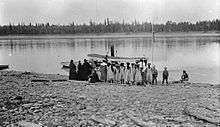 | Messenger | 1905 |
- Steamboat (33' long, 7' beam, screw propeller) operated by the Hudson's Bay Company on the Peace River from 1905 to 1914.
|
| Messenger | |
- Church mission boat used in the Aklavik area c. 1933 – c. 1940
|
 | Midnight Sun | 1904 |
- Built in 1904 by Northern Traders Co. Operated on the Lesser Slave Lake and Lesser Slave River.
|
 | Miskanaw (CCGS) | 1958 |
- Coast guard vessel operated by the Department of Transport on Mackenzie River beginning in 1958. In 1965, it was operating on the Slave River/Athabasca River system in northern Alberta. Decommissioned.
|
| Miss Norman | |
- Diesel tugboat built by Russ Denholm in Waterways, Alberta, for use carrying oil drilling equipment and supplies between Tulita and Fort Smith on the Mackenzie/Slave river routes.
|
| Molly Hogan | |
- Diesel tugboat used by the Northern Transportation Company Limited on the Slave River/Great Slave Lake routes c. 1935/1936.
|
| Nanook | |
- Schooner owned by Charlie Gruben of Aklavik in 1956, purchased used from the Government of Canada.
|
| Nanook II (MV) | |
- Motor schooner (48' long, 11' beam, 4' draft)used by the Government of Canada in the 1940s–1968 in the Mackenzie Delta with service between Aklavik, Inuvik and Reindeer Station. It was also used by Game and Forest Wardens in that area. In the 1970s it was sold to the community of Deline on Great Bear Lake where it was abandoned and later (c. 1981) destroyed by arson.
|
| Netchilik | |
- Boat captained by Johnny Norberg in the Aklavik/Inuvik area 1956, used for freighting on the DEW Line construction. In 1957, it was caught in ice and badly damaged near Tuktoyaktuk. Aka Nitchilik, or Natsilik?
|
| Niangua | |
- Transport vessel used by Eldorado Mining & Refining on Great Bear Lake to transport freight and personnel between its uranium mine at Port Radium and airstrip at Sawmill Bay c. 1946. In 1962, it was owned by Northern Transportation Company and used as a yarding tug at Hay River shipyards.
|
| Nodaway (MV) | |
- Diesel tugboat used by Yellowknife Transportation Company on the Mackenzie River routes c. 1946. A boat by this name was still operating in 1962/1963 by the company, being used to assist with dredge work at Hay River on Great Slave Lake.
|
| Nor Alta | |
- Diesel tugboat used by McInnes Products Corporation, commercial fishers, on the Slave River/Great Slave Lake routes c. 1946 – 1961. It was their flagship vessel. In 1962, the ship was purchased by Carter Fisheries and used a fish packer on Great Slave Lake 1962-c.1963.
|
| Nor Basca | |
- Diesel tugboat used by McInnes Products Corporation, commercial fishers, on the Athabasca/Slave River routes c.1946.
|
| Northland Call | 1910 |
- Steam boat built in 1910 at Athabasca Landing by J.H. Woods and used by Northern Traders Company on the Athabasca/Lesser Slave Rivers until it was scrapped in 1913.
|
 | Northland Call II | 1915 |
- Steam-driven sternwheeler, built in 1915 by George Magar at Peace River, operated by Peace River Navigation Company on the Upper Peace River. Relaunched in 1920 as the Hudson's Hope on the Peace River.
|
 | Northland Echo | 1912 |
- Steam-driven sternwheeler built in 1912 by Northern Traders Company, who thought its shallow draft would enable it to transit the who length of the Peace River. It only transited the Vermilion Chutes once, and only functioned until 1914. It may have been rebuilt (or a new ship of this name built) and operated by Northern Traders Company on the Athabasca and Upper Slave Rivers between Fort McMurray and Fitzgerald. Scrapped in 1923 and rebuilt as Northland Echo II.
|
| Northland Echo II | 1923 |
- Steam-driven sternwheeler (135' long, 24' beam) operated by Northern Traders Company on the Athabasca and Upper Slave Rivers between McMurray and Fitzgerald from 1923–1928 and then by the Hudson's Bay Company from 1929 – c. 1941. Retired at Waterways, Alberta by 1946.
|
.jpg) | Northland Pioneer | 1921 |
- Gas motor vessel (100' long, 20' beam, 90 tons cargo) launched in 1921 at Fort Smith, operated by Northern Traders Company on the Slave and Mackenzie Rivers and Great Slave Lake. It was the first crude oil burning boat used in the Northwest Territories. It may have been destroyed by fire after 1924.
|
 | Northland Star (SS) | 1911 |
- Built in 1911 by Northern Traders Company. Operated on the Athabasca-Slave Rivers from Fort McMurray to Fort Fitzgerald.
|
 | Northland Sun (SS) | 1909 |
- Built in 1909 by Northern Traders Company and operated on the Athabasca/Slave Rivers from Fort McMurray to Fort Fitzgerald.
|
| Northland Trader | |
- Screw steamer operated by Northern Traders Company on the Slave/Mackenzie Rivers c. 1921 until it was wrecked on Great Slave Lake in October 1924. The wreckage can still be seen today on Loutit Island near Fort Resolution.
|
| Northern Prospector | 1934 |
- A motor vessel used by Northern Transportation Company on the Slave/Great Slave Lake routes servicing the Yellowknife gold camp 1934 – c. 1938. It was a derelict at Fort Resolution in 1946.
|
| North Star | |
- Schooner owned by A.W. Boland a free trader on Great Bear Lake c. 1928 – c. 1932, followed by the Northern Transportation Company c. 1935. Also known as the Star?
|
| North Star of Herchell Island | 1935 |
- Schooner (58' long, 15' beam, 6'6" draft, 30 tons tonnage) built in San Francisco in 1935/1936. It was owned by Fred Carpenter in the Western Arctic Ocean near Herchell Island until 1960/1961. It was owned by Sven Johansson in 1967-1973 and used for arctic scientific investigations. Purchased by Bruce Macdonald in 1996.
|
| Norweta (MS) | 1971 |
- A small cruise ship (99' long) with 20-passenger capacity that operated on the Mackenzie River and the Beaufort Sea for many years. Original owners were Arctic Cruise Lines Ltd 1971–1980, followed by Arctic Offshore Ltd. 1982–1988, Pristine Tours 1989–1991, and George and Margaret Whitlock 1991–2009.
|
| Our Lady of Lourdes | 1930 |
- Roman Catholic mission supply boat (17 m long, 5 m beam, 1.75 m draught) in the Western Arctic Ocean, serving communities from Herschell Island in the Beaufort Sea, to Kugluktuk in the Coronation Gulf, 1930-1957. The construction of this schooner, flush-decked, sloop-rigged motor sailer, was overseen in San Francisco by Captain Pedersen. Tuktoyaktuk became her home port in 1940. The vessel made its final journey in 1967 and was winched ashore at Tuk; since 1978, it has been on display near the community's Catholic church. [18]
|
| Peace (MV) | |
- Diesel tug (270 bhp) owned by Northern Transportation Company Limited on the Slave/Mackenzie River routes c. 1946, and later on the Athabasca/Slave River routes c. 1950s. It may have originally been a US Army tug boat used on the Mackenzie River during construction of the Canol pipeline c. 1944, carrying the designation RT-901.
|
 | Peace River (SS) | 1905 |
- Steam-driven sternwheeler (110' long, 24' beam) built 1904/1905 at Fort Vermillion, Alberta and operated by the HBC on the Upper Peace River from Vermillion Chutes to Hudson's Hope. Retired in 1915.[19]
|
| Pelican Rapids (MS) | 1947 |
- Diesel tug (98' long, 28' beam, 3'6" draft, 929 hp), built by Standard Iron Works in Edmonton, owned by the Hudson's Bay Company on the Athabasca/Slave River routes c. 1947, and then moved over the Fort Smith portage to serve the lower Slave River/Mackenzie River routes by 1953. It was acquired by the Northern Transportation Company by 1956 and was still in service in 1973. It is now abandoned in Hay River.
|
| Pelly Lake (MV) | |
- Diesel tug (78' long, 18' beam) owned by the Hudson's Bay Company on the Athabasca/Slave River routes (c. 1931 – c. 1933), on Great Slave Lake (c.1933), and back to the Athabasca/Slave River in c. 1946.
|
| Peter Pond | |
- Motor boat used by Government of Canada on Great Slave Lake c. 1935 – c. 1961 with home port in Fort Resolution, Slave River.
|
| Pilot I | |
- Motor boat used by Government of Canada on Great Slave Lake and Mackenzie River for maintaining navigational beacons and channel markers, c.1942.
|
.jpg) | Pilot II | 1947 |
- Motor vessel (57' long, 15' beam, 14" draft, twin tunnel engine 250 hp, crew of 4) built in Owen Sound, Ontario in 1947 and transported north on railway to Waterways, Alberta. Used by Government of Canada on Great Slave Lake/Mackenzie River for maintaining navigational beacons and channel markers. Rebuilt in 1970 and enlarged to 70' long. In the 1990s, it was owned by Arctic Offshore Limited in Hay River, Northwest Territories. [20]
|
| Pinnebog | |
- Diesel tug (311' long, 49' beam, 18' draft, 5700 hp) owned by the Northern Transportation Company c. 1970s.
|
| Porphyry | 1938 |
- Diesel tug built by Consolidated Mining & Smelting Company (Cominco) at Waterways, Alberta in 1938 and used on the Slave/Mackenzie River routes for many years, first by Cominco, and then by the Hudson's Bay Company (c.1946), and the Northern Transportation Company on Great Slave Lake (c. 1949). It was said to be one of the last wooden-hull boats constructed for use in the NWT. The boat was later used by commercial fishers on Great Slave Lake and a sawmill operator on the Slave River. By 1971, the hull was abandoned 60 miles below Fort Smith on the Slave River and there were plans to restore it as a museum piece but this was never done. [21]
|
| Radium Charles (MV) | 1947 |
- Diesel tug (111' long, 28' beam, 4' draft, 1530 hp), built by Yarrows in Esquimalt, launched by Northern Transportation Company in 1947 for use on the Mackenzie River routes. Still in use by NTCL in 1965. Now drydocked at the NTCL shipyards in Hay River.
|
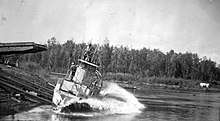 | Radium Cruiser (MV) | 1939 |
- Diesel tug (60' long, 136 bhp) launched by Northern Transportation Company in 1939 for use on the Mackenzie River routes to Great Bear Lake.
|
| Radium Dew | 1955 |
- Diesel tug (120' long, 30' beam, 5' draft, 1540 hp), built by Allied Shipbuilders in Vancouver, launched by Northern Transportation Company in 1955 for use on the Slave/Mackenzie River and Great Slave Lake routes. In 1962-1965 it was supplying communities in the Western Arctic Ocean. Retired in 1976 and sold to Groenewagen family in Hay River.
|
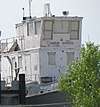 | Radium Express | 1939 |
- Diesel tug (70' long, 20' beam, 3' draft, 240 bhp) launched by Northern Transportation Company in 1939 for use on the Slave /Mackenzie River and Great Slave Lake routes. Rebuilt in 1953. Now drydocked at the NTCL shipyards in Hay River.
|
| Radium Franklin | 1951 |
- Diesel tug (61' long, 24' beam, 2' draft, 460 hp), built by Allied Shipbuilders in Vancouver, launched by Northern Transportation Company in 1951 for use on the Mackenzie River/Bear River routes. Now drydocked at the NTCL shipyards in Hay River.
|
 | Radium Gilbert | 1946 |
- Diesel tug (113' long, 28' beam, 5' draft, 926 hp), built by West Coast Shipbuilders in Vancouver, launched by Northern Transportation Company in 1946 for use on Great Bear Lake to transport uranium ores from Port Radium to the portage at Bear River. The route was abandoned in 1980 with the closure of the silver mine at Great Bear Lake, and the boat donated to the community of Deline for a potential heritage display. Contamination concerns lead to the boat being remediated and cut up for scrap by the Government of Canada in 2005.
|
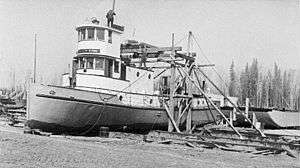 | Radium King | 1937 |
- Diesel tug (96' long, 20' beam, 520 hp) launched by Northern Transportation Company in 1937 for use on the Slave/Mackenzie River/Great Slave Lake routes. The boat was retired in 1967 and donated to the Northern Life Museum in Fort Smith.
|
| Radium Lad | |
- Diesel tug (120 bhp) used by Northern Transportation Company on the Mackenzie/Bear River routes c. 1937 – 1946.
|
| Radium Miner | 1956 |
- Diesel tug (95' long, 28' beam, 2'10" draft, 926 bhp), built by Yarrows in Esquimalt, used by Northern Transportation Company on the Slave/Mackenzie River routes.
|
| Radium Prince | |
- Diesel tug (240 bhp) used by Northern Transportation Company on the Mackenzie/Bear River routes c. 1946 – c. 1966.
|
| Radium Prospector | 1956 |
- Diesel tug (95' long, 28' beam, 2'10" draft, 926 bhp), built by Yarrows in Esquimalt, used by Northern Transportation Company on the Mackenzie River/Great Slave Lake routes. Still in use by NTCL in 1965. Now drydocked at the NTCL shipyards in Hay River.
|
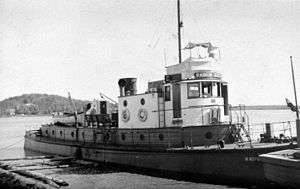 | Radium Queen | 1937 |
- Diesel tug (96' long, 20' beam, 520 hp) launched by Northern Transportation Company in 1937 for use on the Athabasca/Slave River routes. Still in use in the 1950s.
|
 | Radium Scout | 1946 |
- Diesel tug (136 bhp) launched by Northern Transportation Company in 1946 for use on the Athabasca/Slave River routes. The boat was retired and donated to the museum in Fort McMurray.
|
| Radium Trader | 1956 |
- Diesel tug (95' long, 28' beam, 2'10" draft, 926 bhp), built by Yarrows in Esquimalt, launched by Northern Transportation Company in 1956 for use on the Slave/Mackenzie River routes. In 1965, it was being used on the Slave/Athabasca River systems in northern Alberta. Still in use in 1982. Now drydocked at the NTCL shipyards in Hay River.
|
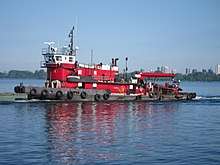 | Radium Yellowknife | 1948 |
- Diesel tug (120' long, 28' beam, 4' draft, 1530 hp) launched by Northern Transportation Company in 1948 for use on the Slave/Mackenzie River/Great Slave Lake routes. Still in use by NTCL in 1963. In the 1990s, it was owned by McKeil Marine and in service on Lake Ontario.
|
| Rae (MV) | |
- Survey boat used by Canadian Hydrographic Survey on Great Slave Lake c. 1961/1962.
|
| Rae | |
- RCMP motor launch used on Great Slave Lake between Fort Rae and Yellowknife in 1945.
|
| Rae Point | 1963 |
- Diesel boat used by Department of Fisheries patrols on Great Slave Lake starting in 1963, with home port of Hay River, Northwest Territories.
|
| Ranger | |
- Boat used by the Government of Canada game warden in the Slave/Peace River area c. 1925/1926.
|
| Rayrock | |
- Boat owned by A.S. Hodgson on Great Slave Lake to move freight from Hay River to the Rayrock Mine road at the north end of Marian Lake, c.1957/1958.
|
| RCMP Jennings | 1953 |
- Formerly the Aklavik II. Motor schooner used by Royal Canadian Mounted Police for patrols in the Mackenzie Delta, Aklavik and Inuvik area 1961–1964. Renamed the Amoulik in 1965 when purchased by the Coppermine Eskimo Cooperative. In 1982 it was purchased by a civilian and it was renamed the Ft. Hearne and refitted with new engine in 1988 and still in service in the Coronation Gulf area in 2000. In 2017 it is drydocked in Kugluktuk, Nunavut.
|
| RCMP Spalding | |
- Boat used by Royal Canadian Mounted Police for patrols in the Mackenzie Delta, Aklavik and Inuvik area 1961–1965. Sold to Coppermine Eskimo Cooperative in 1965 and renamed the Amoulik.
|
| Reliance | |
- Boat used by Royal Canadian Mounted Police for patrols on Great Slave Lake c. 1962
|
| Resolution | |
- Schooner used by Royal Canadian Mounted Police for patrols on Great Slave Lake c. 1921 – c. 1941.
|
| Richard | |
- Diesel tug used by the Yellowknife Transportation Company on the Mackenzie River/Great Slave Lake routes c. 1949 – 1965. The vessel was rebuilt with new superstructure in 1962. Also known as the YT Richard, Richard E and Richard H. Acquired by Northern Transportation Company in 1965 and renamed NT Richard.
|
| Rumley | |
- Fish packer boat owned by Menzies Ltd. in 1965 based out of Hay River, but going to spend the summer in Inuvik. [22]
|
| Saline (MV) | |
- Diesel tug used by the Yellowknife Transportation Company on the Mackenzie River/Great Slave Lake routes c. 1946 – c. 1963. The vessel was rebuilt with new superstructure and relaunched on June 19, 1962 for use on the Slave River/Great Slave Lake routes.
|
| Sandy Jane (MV) | 1946 |
- Diesel tug (800 hp), built by Yarrows in Esquimalt, used by the Yellowknife Transportation Company on the Mackenzie River/Great Slave Lake routes from 1946 to October 1956 when it sank 25 miles south of Yellowknife in a storm. The crew was rescued by another ship. The Sandy Jane was named after the daughter of Earle Harcourt, owner/manager of the Yellowknife Transportation Company.
|
| Sans Sault | 1965 |
- Diesel tug (23m long, 7m beam, 1m draft, 925kW) launched in 1965 by the Canadian Department of Transport as a dredge tender and tug boat on the Mackenzie River routes to Tuktoyaktuk. Later acquired by NTCL. [23]
|
| Santanna | 1936 |
- Roman Catholic mission diesel boat (59'4" long, 14'4" beam, 5'8" draft, 120 hp Atlas-Imperial diesel engine) based in Fort Resolution for use on the Slave/Mackenzie River/Great Slave Lake routes until 1960. It was built by Denim and Curries in Fort McMurray in 1936 as the MLD on order for the Consolidated Mining & Smelting for their gold prospecting on Lake Athabasca. Consolidated cancelled the order even though the boat was completed, and so it was put up for bid. The Roman Catholic Mission's bid was accepted and the boat was renamed Santanna. The boat with a small barge transported freight, food, mission personnel and children attending residential school in the Northwest Territories. After its long service ended in 1960, the boat was kept at the Mission Shipyard outside of Fort Resolution. In 1983 it was dry docked in Hay River at Porritt's Landing for restoration by new owners.[24]
|
| Scamp | |
- Diesel tug used by the Yellowknife Transportation Company on the Mackenzie River/Liard River routes c. 1961 – c. 1963.
|
| Sikanni Chief (MV) | |
- Diesel tug (wooden construction, 55 gross tonnage) used by the Yellowknife Transportation Company on the Mackenzie River routes c. 1946. In 1973, it was a derelict wreck at Axe Point near Mills Lake on the Mackenzie River, YTCL's former shipyard.
|
| Silver Belle | |
- Motor vessel wood-hull pleasure craft used on Great Bear Lake by employees at the Echo Bay silver mine 1960s-1970s. Brought to Yellowknife by Dave Lorenzen in 1976 and sold to David Smith who operated it on Great Slave Lake for many years before it was too far gone to keep in repair. It was disposed of at the Yellowknife city dump c.1994.
|
| Slave (MV) | |
- Diesel tug (270 bhp) owned by Northern Transportation Company Limited on the Slave/Mackenzie River routes c. 1946. It may have originally been a US Army tug boat used on the Mackenzie River during construction of the Canol pipeline c.1944, carrying the designation RT-902.
|
| Slave River (SS) | |
- Steam-driven sternwheeler (125' long, 23' beam, 125 ton cargo, 100 passengers) owned by the Lamson-Hubbard company (1919), Alberta Arctic Transportation (1921), and the Hudson's Bay Company (1924) for use on the Athabasca/Peace/Slave River routes. It was no longer in service by 1924.
|
| Slave River | 1929? |
- Diesel tug operated by Hudson's Bay Company from 1929 – c. 1946 on the Athabasca/Slave River routes.
|
| Sparrow | 1897 |
- Steamboat (steel frame covered in oak, 65' long, two 60 hp marine engines) built at Athabasca Landing in 1897 by George T. Leitch. Sold to Dick Secord in 1898 and then to Hislop & Nagle soon after, who floated it down the Athabasca/Slave Rivers to Fort Fitzgerald and then over the portage to Fort Smith. It was then renamed the Eva Nagle.
|
| Speed | |
- Gasoline schooner operated by the Northern Traders Company c. 1921 – c. 1924 along the Slave/Mackenzie Rivers and Great Slave Lake. It caught fire and sank on Great Slave Lake and was replaced by the Speed II which ironically later suffered the same fate.
|
| Speed II | |
- Gasoline schooner (45' long) operated by Northern Traders Company on Great Slave Lake c. 1927, and later by Northern Waterways Limited on Great Bear Lake 1932–1933. It caught fire and sank on Great Bear Lake in October 1933 killing two people.
|
| Spruce (MB) | |
- Motor boat owned by Government of Canada on Great Slave Lake c. 1952 with home port in Yellowknife. It was used by the Game Warden and other federal officials during summer patrols.
|
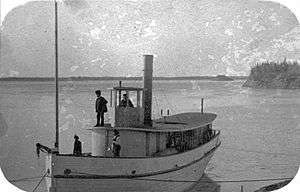 | St. Alphonse | 1894 |
- An Oblate Order mission ship, on the Mackenzie and lower Slave rivers.[25]
|
| St. Ann | |
- Roman Catholic mission boat from 1941–1963 in the Western Arctic Ocean, at Tuktoyaktuk. In 1963 it was sold to someone in Hay River.
|
 | St. Charles | 1903 |
- Roman Catholic mission boat on the Upper Peace River from 1903–1915, the first steamship on the Upper Peace River. It was later owned by Fred Lawrence. [25][19]
|
 | St. Emile | 1902–1903 |
- An Oblate Order mission ship, on Lesser Slave Lake.[25]
|
| St. Gabriel | 1945 |
- Catholic Mission boat on Great Slave Lake based in Fort Resolution c.1945.
|
 | St. Joseph | 1893 |
- An Oblate Order mission ship, on the Athabasca, Peace and upper Slave rivers.[25]
|
| St. Marie | 1907 |
- Catholic Mission boat built and launched in 1907 at Fort Smith on the Slave River. By 1914 it was owned by Northern Traders Company.
|
| Stenodus (MV) | 1956 |
- Department of Fisheries cabin cruiser patrol boat (43' long, 12' beam, 5' draft, 15 tons displacement, 165-hp Cummins diesel engine, V-bottom hull) on Great Slave Lake, built by Matheson Boat Works in Ontario. Used as a patrol boat on Great Slave Lake 1956-c.1962.
|
| Sternwheeler | |
- Steam-powered sternwheeler used by Northern Transportation Company for use on the Mackenzie/Bear River routes c. 1935 – c. 1942. It primarily ran the route from Tulita on Mackenzie River up the Bear River to where the portage into Great Bear Lake started.
|
| Stewart Lake | |
- A gas boat used by the Hudson's Bay Company on the Mackenzie/Liard River routes, with service as far north as Aklavik, c. 1946 – c. 1957.
|
| Tembah | |
- The original ship by this name, a Department of Transport vessel operating on the Mackenzie River and based in Hay River in 1965.
|
| Tembah (CCGS) | 1972 |
- Coast Guard vessel (75.5 m long, 8 m breadth, 0.9 m draft) on Great Slave Lake and up the Mackenzie River. Drydocked in Hay River for potential retrofitting in 2010.
|
| Tern | |
- Survey boat used by Canadian Hydrographic Survey on Great Slave Lake c. 1962/1963.
|
| Thunder River | |
- Tug boat operating on the Mackenzie River between Norman Wells and Hay River in 1949, was involved in the transportation of the former Canol pipeline infrastructure after it was salvaged for resale. [26]
|
| Tilirak | 1962 |
- Boat built in Hay River by Don Violette and launched in 1962 for mission work in the Mackenzie River and Western Arctic Ocean. Tilirak means "messenger" in the Inuit language.[27]
|
| Velox (MB) | |
- Motor boat based in Aklavik c. 1936/1937, used by the Royal Canadian Corp of Signals to supply their radio stations in the Mackenzie Delta and Arctic Coast.
|
| Vic Ingraham | 1971 |
- Diesel tugboat (149.5' long, 50' beam, 3'9" draft, 4700 hp) launched by Northern Transportation Company Limited in 1971 for use in the Western Arctic of the NWT, with home port in Inuvik.
|
| Watson Lake (MV) | 1946 |
- Diesel tug (75', 18' beam, 2'3" draft, 294 hp), built by Standard Iron Works in Edmonton, owned by the Hudson's Bay Company, first on the Peace River by Captain Jack O'Sullivan until 1952, and then on the Slave/Mackenzie routes. It was said to be the last commercial tug boat to operate on the Peace River. Northern Transportation Company owned the boat in c.1963 and later by the Government of the Northwest Territories Department of Public Works. [28]
|
| Weenusk | 1921 |
- Motor boat owned by the Hudson's Bay Company on the Peace River from 1921 to 1939.
|
| Weenusk II | 1940 |
- Diesel tug (85 hp) owned by the Hudson's Bay Company on the Peace River from 1940 to 1951, captained by Douglas Cadenhead. [29]
|
 | Wrigley (SS) | 1886 |
- Screw-prop steamer (90' long, 14' beam, 130 ton cargo) operated by the Hudson's Bay Company, commissioned at Fort Smith in 1886, operating on the Slave and Mackenzie Rivers below Fort Smith. Captain J.W. Mills piloted this vessel from 1893 to 1903. The Wrigley was overhauled and rebuilt in Fort Smith in early 1898, and continued to serve until it was replaced by the S.S. Mackenzie River launched in 1908.[11]
|
| Yellowknife Expeditor | 1949 |
- A war-surplus landing craft, converted in 1949 into a passenger and freight carrying vessel by Yellowknife Transportation Company. It provided scheduled service between Hay River and Yellowknife on Great Slave Lake during the summers of 1949, 1950, and 1951 only. It was damaged by hitting a reef in 1951 so was not used the following summer. In 1958, the craft was transporting freight between Hay River and Aklavik on the Mackenzie River, and in 1962 it was servicing communities in the Western Arctic Ocean where it had overwintered. Following the sale of YTC to the NTCL in 1965, the vessel was taken out of service, and later scrapped at the Fort Smith Bell Rock shipyards in 1969.
|


















.jpg)



.jpg)










